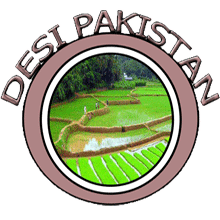Geography, Land, Boundaries and Neighborhoods
1. Geography and the People
2. Boundaries
3. Neighborhoods
1: Geography and the People
Pakistan was comprised of two wings when it came into existence on August 14, 1947. East Pakistan separated in 1971. Post-1971 or present day Pakistan is located in the Northwestern part of South Asian Sub-continent.
It has maintained its distinctiveness in the Sub-continent. Indus Valley Civilization is as old as 2500-1600 BC. The archeological heritage of Harappa and Mohenjo-Daro are clear evidence of this fact. Arians first came to this land followed by Islam and Muslims from Central Asia and Afghanistan. Muslim rule continued about one thousand years. Then the downfall of Muslim empire paved the way for British Rule, which ended with the formation of two independent states of India and Pakistan.
Location:
Pakistan is located between 24_37 degrees North latitude 61_75 degrees East longitude.
Territory:
Its area is 796,095 sq Kilometers.
__________________Territory_____percentage
________________(in thousand)_____%
Balochistan _________347.2_______43.61
Punjab______________205.3_______25.81
Sindh_______________140.9_______17.71
NWFP________________74.6_______9.4
FATA________________27.2_______ 3.4
Islamabad_____________0.9________0.1
Diversity in the nature of territory:
• North and Northwest: It includes Mountains of Himalayan and trans-Himalayan Ranges, Korakoram & Pamirs, which includes some of highest peaks like K2, Nanga Parbat etc.
• West: Baluchistan Plateau is about 1000 feet in elevation with dry mountains crossing it from northeast to the southwest. Here very little rainfall occurs.
• Indus Plains: Main agricultural region in the middle of the Indus valley.
• The Potohar Plateau is there in the East of upper Indus plains.
• In South East of Indus Plains there is Deserts Thal, Cholistan and Thar.
Climate:
Climate of Pakistan is diverse.
North, Northwestern Mountains are extremely cold in winter but mild in summer. The Indus Plains are extremely hot in summer but cold and dry in winter.Coastal regions are having temperate climate. There are some variations within each region.
Four Seasons:
Summer: May to September
Winter: November to February
Spring: March-April
Autumn: September-October
Rain: It varies from region to region. The main rainy season is the summer i.e. Monsoon.
Population:
Pakistan is having a large population. The growth rate recorded over 3 percent in the 1970s to early 1990s. Now declined due to a number of measures by the government but still it is higher as compare to the other countries of the region. Census is taken after every ten years.
--------1951, 1961, 1972, 1981, 1998
-----------------------------------------------
Year Population----Annual Growth
-------In Million-----Percent
1951 -----36.2 --------
1961 -----46.2 ----2.80
1972 -----65.3 ----3.10
1981 -----84.3 ----3.06
1998 -----130.6 ----2.61
*In 2006, the population is estimated to be over 160 million.
Important Features of the Population:
• More than 50 Percent population is under the age of 21. A large part of this population is dependent.
• Add to this people over 65 years.
• About 30 percent population lives in urban areas.
• Why migrations to urban areas: Education, jobs, facilities etc.
• Impact of urbanization: Poor civic conditions, education, health, housing, town planning etc.
• Provincial population. Punjab 56-57 percent Sind 23 percent NWFP 14 percent Baluchistan 5.3 percent
• Low literacy rate: Official literacy rate is 46 percent but functional literacy rate is even lower.
• Women literacy rate is much lower. In certain areas of Baluchistan women literacy is nominal to non-existent.
• Why population figures are important. For Planning and development, Socio-economic development and poverty alleviation etc.
• Social development indicators are poor in Pakistan. No ideal figure for population can be named. It depends upon the resources. High population is asset as well as a liability because we cannot feed them.
• Efforts to manage population are being done by the Government as well as by non-governmental organizations in the field of health care, family planning and education.
2: Boundaries:
Pakistan shares boundaries with four countries.
• China in the northeast: About 600 km long border in the Northern Areas. Silk Route is a major link for trade and traveling.
• Afghanistan: North and Northwest about 1200 miles. Durand Line was drawn on
November 1893 as a border between the two neighbors.
• Iran in the West share about 590 miles border from Koh-i-Malik Siah to Gawadar.
• India in the East having a border about 1400 miles which was established in August
1947.
• We also face India on the LOC in Kashmir, the most troubled frontier having hardly any natural barriers, highly volatile and porous.
• South: Arabian Sea, Coastline 450 miles. Stretches from the Rann of Kutch Indian border to the Iranian border in the West.
3: Neighborhoods:
Pakistan is located in strategically important region. It is the center of global interests. For all the big powers like China and Russia it is important. U.S maintains interests to keep an eye on both China and Russia.
It is on the gateway of Central Asian Muslim States through Afghanistan. On the other side of it is the outer region of the Gulf region having rich oil resources and economic wealth. Pakistan has close brotherly ties with these states. Now the pipelines of oil and gas are planning to be passed through Pakistan. It will be a new start of economic cooperation in the region.



Post A Comment:
0 comments: